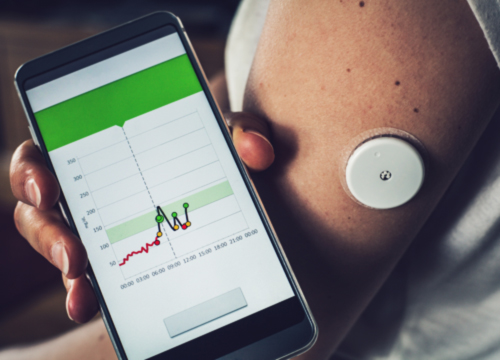Personal Biosensing Featured Signal of Change: SoC1266 November 2021

In combination with artificial intelligence, new sensing technologies promise to enable transformative new capabilities for personal health monitoring. Wearable devices could one day incorporate biosensors that measure blood glucose, stress hormones, and other biochemical indicators. These new kinds of personal-biosensing capabilities could open up many new opportunities in health care, wellness, and nutrition. Personal biosensors could help reduce health-care costs by making diseases easier to detect and manage. AI systems could use data from personal biosensors to make precise recommendations about food, exercise, sleep, and other factors to help maximize an individual's health, productivity, and well‑being.
Personal biosensors could help reduce health-care costs by making diseases easier to detect and manage.
Existing wearable devices use a mix of low‑cost microsensors and motion sensors to sense simple bioindicators, including heart rate, respiration rate, and skin temperature. Creating wearable sensors that sense chemical bioindicators such as blood glucose, cortisol, and disease indicators is technically challenging, and current approaches to sensing such chemical bioindicators tend to be inconvenient, uncomfortable, and inaccurate. Researchers have been exploring ways to enable accurate chemical biosensing without requiring direct sampling of bodily fluids. Noninvasive sensing methods under investigation have included electromagnetic, electrical, optical, acoustic, and thermal sensing. Glucose-monitoring devices that leverage one or more of these noninvasive sensing methods in combination with advanced AI have begun appearing on the market, but no device has achieved mainstream success thus far.
Many start-ups have been developing noninvasive wearable biosensing devices that measure blood glucose, hoping to tap into a vast and growing market for glucose monitoring. Some examples include Afon Technology (Caldicot, Wales), DiaMonTech (Berlin, Germany), and LifePlus (San Jose, California). Each of these companies is developing sensor technology that can—in theory—reside within a smartwatch and includes no components that a user needs to replace. Notably, none of these companies' smartwatch products have earned regulatory approval as medical devices yet, but a much larger desktop device from DiaMonTech gained regulatory approval in Europe in 2019.
Apple (Cupertino, California) and Samsung Group (Seoul, South Korea) reportedly have been developing noninvasive glucose-biosensor technology for integration into their smartwatch devices. Reports from early 2021 suggested that Apple's device would appear on the market in 2021 and potentially make use of optical-sensing technology from Rockley Photonics (Pasadena, California). But those reports proved to be inaccurate: The 2021 version of the Apple Watch included no glucose-monitoring functionality.
Nemaura Medical's (Loughborough, England) SugarBEAT is a wearable noninvasive glucose-monitoring device that has regulatory approval in Europe. The device does provide sufficient levels of accuracy and reliability (though significantly lower levels than those an invasive test provides), but it is too inconvenient to gain very widespread use. The device comes in the form of a stick‑on patch that a user must replace every 24 hours. Also, the device functions by drawing fluid through pores in the user's skin, which causes some discomfort.
Although companies that are developing advanced personal-biosensing technologies for wearable devices will likely continue to attract funding and media attention, severe technical challenges will likely prevent any products from achieving mainstream success. Meanwhile, services that use health data from wearable devices will likely continue to improve the quality and variety of benefits that they provide for end users, attracting a larger market. However, the future is uncertain, and changing conditions could trigger alternative outcomes. Some examples of potential events that could transform the future of personal biosensing follow:
- Emergence of a convenient, totally noninvasive glucose-sensing device that actually works. Skeptics claim that no physical way exists to measure the concentration of glucose or other biomolecules in human blood reliably without using methods that are at least minimally invasive. Given the decades that researchers have spent exploring the problem without any real success, the skeptics make a very powerful case. At this point, only a working device would provide convincing evidence that the skeptics are wrong.
- Emergence of new form factors for personal biosensors. The first widely successful personal biosensor does not necessarily have to be a smartwatch with some kind of noninvasive sensing technology. Many other convenient form factors are possible. For example, smart contact lenses could perform direct chemical biosensing without requiring periodic replacement. And smart pills that users swallow could perform sensing without causing discomfort. These kinds of devices have so far failed to work well, but they might ultimately succeed where truly noninvasive devices have failed.
- Advances in technology for automated interpretation of personal health data. Current personal-health-monitoring devices already provide a large amount of detailed health information that used to be unavailable except by way of a diagnostic test from a trained medical professional, who would then interpret and explain the test results to the patient. Without skilled interpretation, health data can easily be misleading, causing people to worry about medical problems that they do not actually have or causing them to make lifestyle changes that end up being harmful. Without serious improvements to tools that automatically interpret health data, advances in personal biosensing could end up doing more harm than good.
The temptation exists to imagine a future in which AI somehow overcomes long-standing limitations in sensing technology and enables truly noninvasive biosensing technology to become workable. Despite experts' skepticism, this type of future is plausible. AI has already shown remarkable capacity to improve sensors' performance—especially when fusing data from multiple sensors. Technology advances in data privacy, synthetic data, simulation, and AI‑processor design are beginning to make developing AI for medical applications much less expensive. Imaginably, these advances could reduce the costs of designing, testing, and validating technologies for noninvasive biosensing, leading to an explosion of progress in the field. The hope is that the same technologies will also result in much better AI systems that help people understand what to do with all the data that biosensing technologies collect.